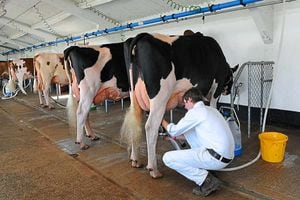Special report: Is it doom for the Shropshire milk industry?
The milk price crisis which is battering Shropshire's farming industry is unprecedented, getting worse, and could doom the British dairy industry, experts have warned.

UK farmers are producing almost three million more litres of milk every day than they have on average over the course of the last three years, despite one of the main export markets for our milk disappearing.
Tit-for-tat sanctions imposed by Russia on imported food and drink as tensions in the Ukraine ramped up led to all exports of milk and milk-based products to the world's largest country drying up overnight.
This video is about getting milked
Posted by Rob Manford on Tuesday, 4 August 2015
With production running high and international requirements for milk dwindling, it's little surprise that the laws of supply and demand have had a serious effect on the price paid to farmers.
"The main driving force behind the fact the prices farmers are receiving has dropped, is a global imbalance of supply and demand," said Patty Clayton, a senior analyst at AHDB Dairy, a not-for-profit market intelligence organisation which provides support for British farmers.

Many Shropshire farmers find themselves in difficult conditions as market woes continue to have a serious impact on their businesses.
Further price cuts are difficult to stomach and too many of our members are telling us they are being paid 14p per litre or less – this is unacceptable.
For the NFU it is an important time to be lobbying decision makers and reinforcing the message about the impact of dire prices on farms, but for the wider industry it is important to work together.
Commentators and analysts continue to point to overproduction, but farmers are rightly quick to point to the consistent and steady prices that consumers can, do and will pay, when asked, for processed dairy products.
What's more the latest Government statistics show that the UK dairy trade deficit is still almost £1.2 billion, meaning the UK public consumes more dairy than UK farmers produce.
So while global overproduction is holding back commodity prices, here in the UK the problem is more one of processing and access to our own stable and profitable markets.
This very issue was one the industry and the NFU tried to address in 2013 and 2014 with strategic projects to get more British dairy products into higher value export and domestic markets.
These objectives to grow our share of the dairy product marketplace are still very important, particularly when we see competitors overseas investing heavily in innovation, efficiency and market development.
However, we are all too aware that for our members these lofty long-term strategic aims are little comfort when what you get back from the market doesn't pay the bills.
With this in mind, the NFU's food chain unit has had a comprehensive programme of supply chain meetings in the past months.
Our head of food chain unit, Ruth Mason, has been very busy ensuring retailers, food service operators and food manufacturers understand the impact of low prices and volatility on their supply base.
We also continue to meet with the banks, agricultural supply industries and others to see what can be done to ease the financial pressure on the sector.
The NFU will continue to fight for more British farmed food to end up on consumers' plates in higher value forms and for fairer trading terms and contractual conditions to help insulate members from the impact of commodity volatility.
We reiterated this to Defra minister George Eustice just a few weeks ago and made it clear just how bad it is at the moment and the potential fallout.
We desperately need the Government's help to ensure a fully functioning and fair dairy supply chain.
There's so much more that can be done to promote high quality, traceable UK dairy products to help drive consumption.
With the outlook bleak in the short term it's important that members keep talking to us and their elected NFU farmer officeholders.
But they must also to talk to their banks, their feed merchants, suppliers and business consultants now, before things get far worse. We also encourage farmers to use the resources available at AHDB to help plan their business to ride this storm out. Most importantly, farmers need to speak to their milk, livestock, grain and other commodity buyers to ensure open and honest communication on the market and future prospects and future demand.
We need the industry and AHDB to get out and promote British food products.
There is no magic lever to pull that will make it all better. However, that doesn't mean we should or will stop trying. This is why the NFU is working with Farmers' For Action, the Tenant Farmers Association, the CLA and others to help signpost help for the short term and find agreed solutions for the long term.
We all want to be part of a growing, successful farming industry but the next 12 months is going to be incredibly tough.
While we're no longer surprised by lower prices, we have every right to be outraged at anything less than the cost of production and it is completely reasonable to expect and demand a better deal for farmers, so that's what we're doing.
"It is something that has been building up for the last couple of years. The cycle of dairy means that you can't just turn supply on and off when it's not needed.
"We had a combination of very strong buying from China, and farmers in Europe getting ready for the disappearance of quotas. It pushed up production on the back of high prices.
"Globally, we were getting more and more milk being produced until we got to the stage where it tipped over, and that see-saw you would expect to see went a long way to one side.
"Russia's ban made the imbalance a lot steeper than had been expected, and China began to build up massive stocks, which combined with their milk production recovering and the fact that their economy is not growing as fast meant that their buying slowed right down."
Production ramped up following a spike in prices after an awful year's weather across the northern hemisphere a few years ago, and was left at unsustainably high levels when the market contracted with unusual suddenness.
Matters are still a long way from being resolved, Ms Clayton added, and farmers, whose numbers are already falling in the face of an unprofitable landscape, are coming towards a time of year when money gets even tighter.
Not only that, but the changing face of farming means there's no real precedent for the current situation.
"There is not going to be a short-term fix to the current global situation," she said. "We are starting from a point where there's more milk than we need, and production is not slowing down yet.
"The bigger the build-up of stocks, the longer it will take to get out of the cycle, as we need production to drop to a level that matches demand, and then get through the stocks.
"That's going to take some time. We are going into a phase where farmers will have to start feeding, and the cost of production tends to be higher in the third and fourth quarters of the year.
"Going into that period, that's when margins will start to be affected and I think it's already starting.
"Grass is already getting less, and farmers are going to have to start making tough decisions to keep their businesses afloat. At that point they will start making decisions that impact production, and we can start to see production pulling back."
She added: "The dairy world has changed so there isn't really a precedent for this.
"We had a lot of supply management, like quota systems and export subsidies. There was a lot of market support provided by the European Commission.
"It wasn't until that gradually disappeared we have started to see price swings becoming a lot bigger.
"Even after the economic crash, when prices shot through the roof then plummeted, we had extreme weather events which shorted the market. Right now we haven't had that."
Bridgnorth farmer Richard Yates, chairman of the NFU in Shropshire, said the challenges faced were creating an "inexorable slide" towards the end of British dairy farming.
"It's one knock after another," he said. "I talk to a number of producers and I know some that say we will struggle to last until Christmas because the economics simply don't add up.
"There's only so long you can go on losing money, and the farms are the hub of the wheel, and whether it's the feed suppliers, or the machinery dealers, they all feed off the back of the farmers.
"Milk processors and retailers continue to drop the price almost on a monthly basis and there's no bottoming out. We can't put a bottom to the market and that's why so many producers are literally at their wit's end.
"There will be sporadic protests. Farming isn't a vocation, it's a business, and sadly the supermarkets and retailers that dictate our existence don't seem to take that into account.
"They think they can pass on their misguided price wars and drop them at the farmers' door."
The latest protests have seen farmers take to the supermarket aisles to challenge the price consumers pay for their liquid milk.
Yet supermarkets' liquid milk contracts are actually among the best-paying in the country.
Suppliers to Tesco and Sainsbury's through co-operative group Arla are receiving upwards of 30p per litre for their produce.
However, Ms Clayton said the pressure that the low shelf price puts on the rest of the supermarket sector in the UK means the knock-on effect ultimately comes back to farmers.
A study by market research group Mintel earlier this year found that 51 per cent of consumers would be willing to pay more for their milk, yet supermarkets see it as part of a group of key goods whose price affects where shoppers choose to visit.
The UK's average farm-gate milk price in June stood at 23.66p per litre. At the same time last year farmers would have received a third more than that, with producers paying an average of 31.66p per litre as of June 2014.
That price has fallen every month since February, when average prices faced a sudden drop of 3p per litre, wiping out at a stroke the profits of shell-shocked producers.
It will be of little comfort to our farmers to know that they are not alone when it comes to the peppercorn prices they are paid for their produce.
Unless you were to move to Cyprus, where farmers are paid more than 40p for a litre of milk, you would probably struggle to meet production costs regardless of where you might be, with exporting countries all affected by the downturn in prices.
As of June, German producers were receiving 20.87p per litre, French producers 21.83p, and Dutch producers 21.34p – all below the UK's average of 22.52p for that month.
Further afield, the USA has suffered a 25 per cent fall in prices paid over the last year, after recording a farm-gate average of 23.18p in June, while New Zealand has fallen even more sharply, with producers receiving 16.42p per litre after a 49 per cent year-on-year decline.
Of even less comfort will be the developing trend in downward movement in prices, however. Just when it appears the market is bottoming out, it seems to take a turn for the worse. The latest Global Dairy Auction, a key measure of the international value of dairy products, took place on Tuesday, and demonstrated that dairy prices are continuing to slump.
Average prices paid for all dairy products dropped by 9.3 per cent in this month's auction, to $1,815 per metric tonne – the 10th consecutive monthly fall in prices.





